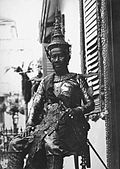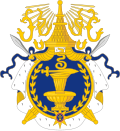Top Qs
Timeline
Chat
Perspective
Monarchy of Cambodia
From Wikipedia, the free encyclopedia
Remove ads
The monarchy of Cambodia is the constitutional monarchy of the Kingdom of Cambodia. The king of Cambodia (Khmer: ព្រះមហាក្សត្រកម្ពុជា) is the head of state and head of the ruling Royal House of Norodom. In the contemporary period, the king's power has been limited to that of a symbolic figurehead. The monarchy had been in existence since at least 50 AD except during its abolition from 1970 to 1993. Since 1993, the king of Cambodia has been an elected monarch, making Cambodia one of the few elective monarchies of the world. The king is elected for life by the Royal Council of the Throne, which consists of several senior political and religious figures. Candidates are chosen from among male descendants of King Ang Duong who are at least 30 years old, from the two royal houses of Cambodia (the House of Norodom and the House of Sisowath).
This article needs additional citations for verification. (January 2017) |
Remove ads
Role
Summarize
Perspective
Cambodia's constitution, promulgated in 1993, stipulated the king's role as a mainly ceremonial one. It declared that the king "shall reign, but not govern"[1] as well as being the "symbol of national unity and continuity".[2]
The king performs important functions of state as required by the constitution. This includes but is not limited to:
- Appointing the prime minister and the Cabinet.[3]
- Convening over the opening of the two legislative bodies, the National Assembly of Cambodia and the Senate of Cambodia.[4][5]
- Serving as the supreme commander of the Royal Cambodian Armed Forces.[6]
- Presiding over the Supreme Council of the National Defense.[7]
- Meeting with the prime minister on a semi-monthly basis in which the king is briefed on matters of state.[8]
- Signing the royal code/decree that gives effect to laws enacted by the legislature and proposals by the cabinet.[9]
- Acting as "supreme arbiter" to enable the functioning of state institutions.[10]
- Receiving credentials from ambassadors.[11]
- Possessing the power of commutation and pardon.[12]
- Presiding over the Supreme Council of the Magistracy.[13][14]
- Appointing a fixed number of members to serve on state institutions such as the Senate and the Constitutional Council.[15][16]
- Awarding of national honours.[17]
The king also fulfils other roles not explicitly mentioned in the constitution in his capacity as head of state, for example, presiding over events of national significance[18] including religious ceremonies and traditions integral to the Khmer nation,[19] supporting humanitarian and philanthropic causes,[20] and representing Cambodia abroad when undertaking official visits overseas.[21] Although there have been female rulers in the past, the 1993 constitution currently forbids women from succeeding to the throne.[22]
Remove ads
Ministry of the Royal Palace
The Ministry of the Royal Palace, currently overseen by Minister Kuy Sophal in conjunction with the Supreme Privy Advisory Council, formerly headed by the King's half-brother Prince Norodom Ranariddh and now headed by former Prime Minister Hun Sen assists and advises the king accordingly in carrying out his duties as monarch.[23][24][25]
Mythological history
- Sage Kambu Swayambhuva
Ancient period (68–1431)
Summarize
Perspective
Funan (68–627)
Chenla (550–802)
Khmer Empire (802–1431)
Remove ads
Middle period (1431–1863)
Chaktomuk era (1431–1525)
Longvek era (1525–1594)
Srei Santhor era (1594–1620)
Oudong era (1620–1863)
Remove ads
Modern period (1863–present)
French protectorate of Cambodia (1863–1953)
First Kingdom of Cambodia (1953–1970)
Second Kingdom of Cambodia (1993–present)
Remove ads
Royal symbols
- Royal Arms of Cambodia (1953–1970), restored 1993
- Royal Arms of Cambodia (1864–1953), lesser arms (1953–1970)
- Royal Standard of the King of Cambodia (until 1970)
- Royal Standard of The King of Cambodia (since 1993)
See also
Notes
- Son of Outey, which was the brother to Chey Chettha II
References
External links
Wikiwand - on
Seamless Wikipedia browsing. On steroids.
Remove ads
















